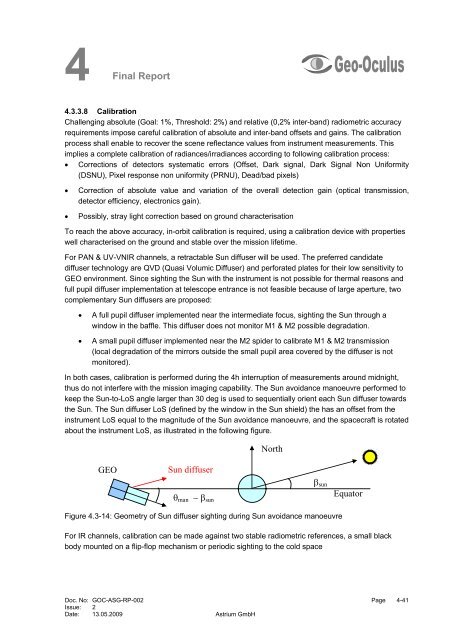4 Final Report - Emits - ESA
4 Final Report - Emits - ESA
4 Final Report - Emits - ESA
You also want an ePaper? Increase the reach of your titles
YUMPU automatically turns print PDFs into web optimized ePapers that Google loves.
4 <strong>Final</strong><br />
<strong>Report</strong><br />
4.3.3.8 Calibration<br />
Challenging absolute (Goal: 1%, Threshold: 2%) and relative (0,2% inter-band) radiometric accuracy<br />
requirements impose careful calibration of absolute and inter-band offsets and gains. The calibration<br />
process shall enable to recover the scene reflectance values from instrument measurements. This<br />
implies a complete calibration of radiances/irradiances according to following calibration process:<br />
• Corrections of detectors systematic errors (Offset, Dark signal, Dark Signal Non Uniformity<br />
(DSNU), Pixel response non uniformity (PRNU), Dead/bad pixels)<br />
• Correction of absolute value and variation of the overall detection gain (optical transmission,<br />
detector efficiency, electronics gain).<br />
• Possibly, stray light correction based on ground characterisation<br />
To reach the above accuracy, in-orbit calibration is required, using a calibration device with properties<br />
well characterised on the ground and stable over the mission lifetime.<br />
For PAN & UV-VNIR channels, a retractable Sun diffuser will be used. The preferred candidate<br />
diffuser technology are QVD (Quasi Volumic Diffuser) and perforated plates for their low sensitivity to<br />
GEO environment. Since sighting the Sun with the instrument is not possible for thermal reasons and<br />
full pupil diffuser implementation at telescope entrance is not feasible because of large aperture, two<br />
complementary Sun diffusers are proposed:<br />
• A full pupil diffuser implemented near the intermediate focus, sighting the Sun through a<br />
window in the baffle. This diffuser does not monitor M1 & M2 possible degradation.<br />
• A small pupil diffuser implemented near the M2 spider to calibrate M1 & M2 transmission<br />
(local degradation of the mirrors outside the small pupil area covered by the diffuser is not<br />
monitored).<br />
In both cases, calibration is performed during the 4h interruption of measurements around midnight,<br />
thus do not interfere with the mission imaging capability. The Sun avoidance manoeuvre performed to<br />
keep the Sun-to-LoS angle larger than 30 deg is used to sequentially orient each Sun diffuser towards<br />
the Sun. The Sun diffuser LoS (defined by the window in the Sun shield) the has an offset from the<br />
instrument LoS equal to the magnitude of the Sun avoidance manoeuvre, and the spacecraft is rotated<br />
about the instrument LoS, as illustrated in the following figure.<br />
GEO Sun diffuser<br />
θman − βsun<br />
North<br />
Figure 4.3-14: Geometry of Sun diffuser sighting during Sun avoidance manoeuvre<br />
For IR channels, calibration can be made against two stable radiometric references, a small black<br />
body mounted on a flip-flop mechanism or periodic sighting to the cold space<br />
Doc. No: GOC-ASG-RP-002 Page 4-41<br />
Issue: 2<br />
Date: 13.05.2009 Astrium GmbH<br />
βsun<br />
Equator

















